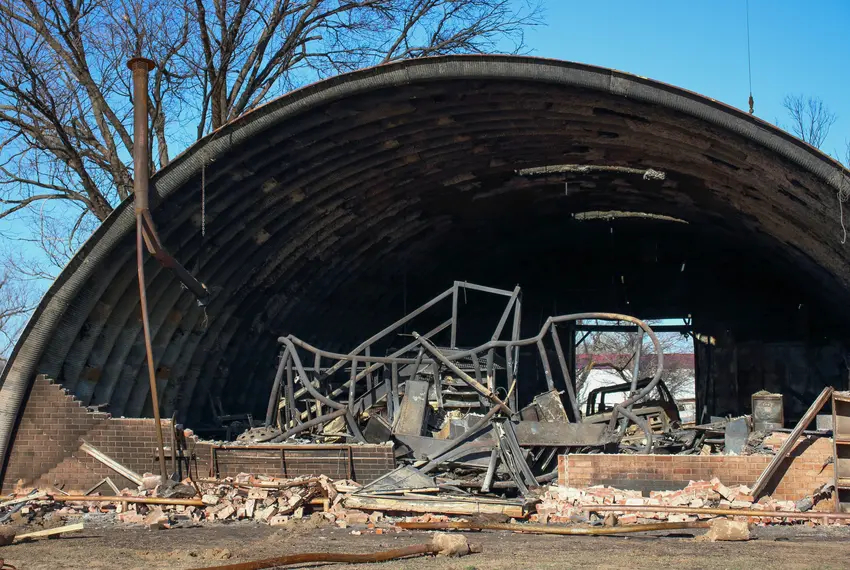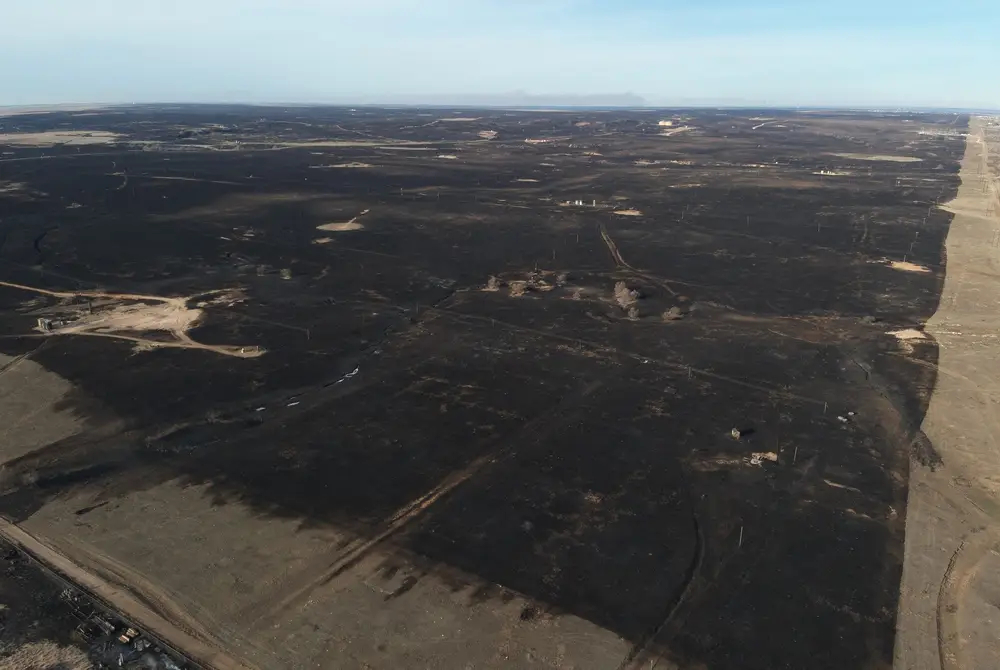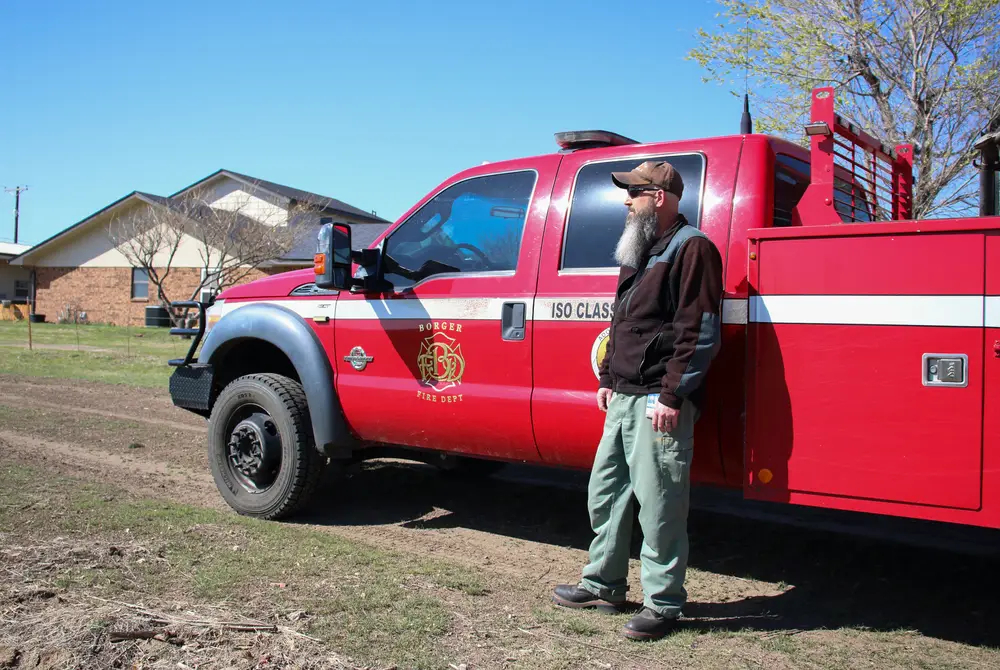
By Keaton Peters, Inside Climate News
BORGER Months before the Texas Panhandle erupted with destructive wildfires, fire crews in Borger were igniting fire intentionally on a seven-mile, roughly 250-foot wide ribbon of land on the edge of town.
The prescribed burn in November removed dense grass and brush next to homes on the southwest side of of the town. When the Windy Deuce fire ravaged the region in February, the prescribed burn area acted as a fireproof wall that stopped the blaze in its tracks.
“I would bet my next paycheck, if that black line had not been there, we would have lost homes and, it’s quite possible, lives. There’s no doubt in my mind,” said Archie Stone, wildland fire coordinator for Borger, located 50 miles northeast of Amarillo. Stone is a state certified and insured burn manager in Texas and has spent decades fighting wildfires around the country.
The Windy Deuce fire burned an estimated 144,045 acres before it was contained. Nearby, the Smokehouse Creek fire burned more than a million acres as it became the largest wildfire in Texas history, decimating multiple counties and crossing into Oklahoma. At least two people died, hundreds of buildings burned and thousands of livestock were killed.
The region has seen fires throughout its history, with 90% of the largest wildfires in Texas recorded in the months between January and May, most of them in west Texas and the Panhandle. After massive fires in 2006 claimed 12 lives, the Borger fire chief and city council looked for ways to protect their town. They turned to prescribed burning.
Before modern firefighting and fire suppression techniques, fires across forests and grasslands were a part of the Earth’s natural cycles. Prescribed burning is an ancient technique still practiced by some Native Americans. In the range ecosystem that dominates the United States from the Texas Panhandle through the Great Plains, land managers and firefighters are recommending prescribed burns to protect communities and restore natural fire cycles. But in Texas, prescribed burning has yet to be widely accepted.
Climate change continues to increase the wildfire risk in Texas, which is part of the region in the United States most affected by high temperatures and long dry spells. Climate scientists warn that the wildfire season in the state is likely to grow longer and more intense.
“We’ve had a trend of increasing temperatures in the state of Texas for several decades, and that trend is expected to continue,” said John Nielsen-Gammon, the state climatologist and a professor at Texas A&M University.
Wildfires thrive in dry and windy conditions. More swelteringly hot days contribute to increased rates of evaporation. “Essentially, that means things dry out faster between rainfall,” Nielsen-Gammon said. “That would tend to lengthen the period of time over the course of the year in which wildfire is possible.”
Long dry and unseasonably hot periods are “where climate change comes in,” said Katharine Hayhoe, a professor at Texas Tech University and chief scientist for The Nature Conservancy. “It’s the difference between smaller, more easily contained fires, and really large out of control fires.”
By 2050, the number of days with wildfire danger in Texas could increase by as many as 40 days per year, according to the Desert Research Institute at the University of Nevada at Reno. Its recent study analyzed a global climate model simulation and various wildfire danger indicators and found that high heat and dry periods will lengthen the wildfire season.

In the days leading up to this year’s fires, temperatures in the region surpassed 80 degrees, with the cities of Amarillo and Borger measuring record-high temperatures for late February. The Panhandle was not in drought, but higher temperatures quickly dried out tall grass. Then, the winds came.
The Smokehouse Creek fire spread from 40,000 acres on Feb 27 to more than 900,000 within two days. The fire began on Feb. 26 north of Stinnett. State officials are investigating the fire, but Xcel Energy, a major U.S. electric and natural gas company, has acknowledged that “its facilities appear to have been involved” in igniting the blaze.
From Stinnett, the fire headed east and burned about 80% of both Hemphill and Roberts counties. “It was a massive monster of a wildfire,” said Andy Holloway, a former rancher in the small city of Canadian. He was among the lucky ones, with no damage to his home, land or cattle.
Holloway is the Hemphill County agent in agriculture and natural resources for the Texas A&M Agrilife Extension Service. He said a wet spring and summer in 2023 brought about enormous grass growth. “Dry dead grass in the winter is like standing gasoline,” Holloway said. “All it needed was a spark.”
Eastern red cedars add to the risk. The trees, native to the Great Plains, were planted in Texas to control normal wind patterns but now provide ready tinder for fast-spreading fires.
Former wildland firefighter Morgan Treadwell works as a range specialist for the Texas A&M Agrilife Extension Service and is an advocate for prescribed burns. Among the wildfire risk factors of fuel, wind and dryness, “the one that we can manage is fuel loads,” said Treadwell, who is also an associate professor at Texas A&M University. “We can do that with livestock and we can do that with fire.”
Texas state law protects the right of private landowners to ignite fires on their own land when a burn ban is not in effect. Certified and insured burn managers are typically hired to conduct burns, and they are allowed to use prescribed fire during a burn ban. Landowners or any burn managers they hire can be liable for harm if a fire they start enters and scorches someone else’s land. Liability remains even if no crops or structures are damaged.
Certified burn managers are trained to monitor weather and wind conditions and to evaluate if the land has become dangerously dry. They also survey the land and plan how to use natural firebreaks to help contain the burn. But “weather is the most unpredictable factor in all of this,” Tradwell said, noting that prescribed burning comes with an inherent risk.
The seven-mile prescribed burn near Borger was located on the Four Sixes Ranch, which was a willing partner with the city. But Texas landowners generally are cautious if not reluctant toward prescribed burns.
“People are scared to use a tool like controlled burning for fear they’ll be sued,” Holloway said, adding that “there’s been a few people that have really been heavy handed” filing or threatening lawsuits.
Treadwell agreed that ranching culture is divided over prescribed burns. “Some neighbors can get pretty hateful when it comes to one neighbor burning and the other neighbor not wanting it,” she said.
The Texas A&M Forest Service helps fight fires that overwhelm local departments. It has authority to conduct prescribed burns in state forests, although land in Texas is overwhelmingly owned by individuals and private corporations. The forest service offers reimbursements to qualifying landowners who do prescribed burns, but owners bear the upfront cost and legal liability.
Karen Stafford, a wildfire prevention program coordinator for the forest service, said the city of Borger “set the bar high in showing the effectiveness of prescribed burns and what it can do in community protection.”
Stone, who now oversees Borger’s wildlands, said public engagement on prescribed burning has been crucial. Stone, who joined the fire department there in 2011, said fire personnel continue to personally visit houses near future burn areas and distribute pamphlets with information and a phone number to call with questions. He said the department works hard to engage and meet with residents, the city council and the mayor before starting new prescribed burns. “Now people don’t even think twice,” he said. “We put out notifications, and they know they’re going to see some smoke in the air. They understand why we’re doing it.”

The Texas A&M Forest Service also encourages cities and counties to develop community wildfire protection plans that identify ways to lower wildfire risk and to protect lives and structures. As of this month, only three municipalities — including the city of Borger — and two counties in the Panhandle have a community wildfire protection plan.
The state forest service’s wildfire protection plan contains no mention of climate change, rising temperatures or heat. Stafford would not comment on global climate change as a factor in the state’s wildfire plans. The forest service publishes quarterly wildfire outlook reports as well as daily assessments based on actual weather conditions at more than 150 stations across the state.
The wildfire outlook report published in December for the “dormant” season of winter and early spring predicted “fire season will be normal to below normal.”
As climate change spurs more days of hot dry weather, the months and weeks of ideal conditions for prescribed burns will shorten. Still, after a historically destructive 2024 wildfire season, the success of Borger’s prescribed burn has generated interest in that mitigation technique.
In Canadian, Holloway knows ranchers who have lost everything and he thinks residents across Texas may “reconsider” their aversion to prescribed burns.
“Fire is a good tool to use,” he said. “I think this is a big wake up call.”
Disclosure: Texas A&M AgriLife, Texas A&M AgriLife Extension Service, Texas A&M University, Texas Tech University and the Nature Conservancy have been financial supporters of The Texas Tribune, a nonprofit, nonpartisan news organization that is funded in part by donations from members, foundations and corporate sponsors. Financial supporters play no role in the Tribune’s journalism. Find a complete list of them here.
This article originally appeared in The Texas Tribune at https://www.texastribune.org/2024/04/15/texas-wildfires-panhandle-prescribed-burn/.
The Texas Tribune is a member-supported, nonpartisan newsroom informing and engaging Texans on state politics and policy. Learn more at texastribune.org.



